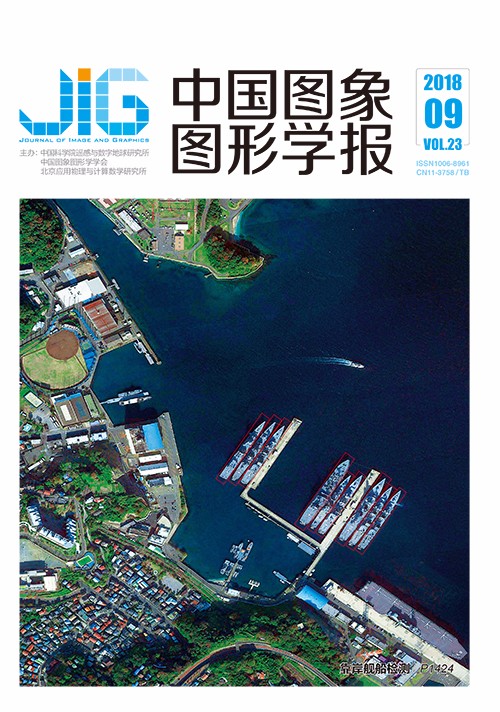
LoVPE 3维局部特征描述子
摘 要
目的 局部特征描述子在3维目标识别等任务中能够有效地克服噪声、不同点云分辨率、局部遮挡、点云散乱分布等因素的干扰,但是已有3维描述子难以在性能和效率之间取得平衡,为此提出LoVPE(局部多视点投影视图相关编码)特征描述子用于复杂场景中的3维目标识别。方法 首先构建局部参考坐标系,将世界坐标系下的局部表面变换至关键点局部参考坐标系下的局部表面;然后绕局部参考坐标系各坐标轴旋转K个角度获得多视点局部表面,将局部表面内的点投影至局部参考系各坐标平面内,投影平面分成N×N块,统计每块内投影点的散布信息生成特征描述向量;最后将各视点特征描述向量进行两两视图对相关编码得到低维度特征描述向量,采用ZCA(零项分量分析)白化降低特征描述向量各维间相关性得到LoVPE描述子。结果 在公用数据集上进行不同描述子对噪声、不同分辨率、遮挡及杂波等干扰鲁棒性的特征匹配实验,实验结果表明,提出的描述子特征匹配率与现有最佳描述子处于同等水平,但保持了较低的特征维度和较高的计算效率,维度降低约1半、特征构建及特征匹配时间缩短为现有最佳描述子的1/4。结论 提出一种新的3维局部特征描述子,具有强描述能力,对噪声、不同网格分辨率、遮挡及杂波等具有强鲁棒性,存储消耗较少且计算效率较高,该方法适用于模型点云及真实点云数据,可用于复杂场景中的3维目标识别。
关键词
LoVPE three-dimensional local feature descriptor
Chen Quan1, Lyu Wu2, Fang Bin1, Yue Zihan1, Ma Jie1(1.Nation Key Laboratory of Science and Technology on Multi-Spectral Information Processing, Huazhong University of Science and Technology, Wuhan 430074, China;2.System Engineering Research Institute of China State Shipbuilding Corporation, Beijing 100036, China) Abstract
Objective In recent years, due to the availability of low-cost scanners and high-performance computing devices, three-dimensional object recognition has become an active research area in computer vision tasks. Local feature descriptors can effectively overcome the interference of noise, different point cloud resolution, local occlusion, scattered cloud point distribution, and other issues in 3D object recognition tasks. However, difficulties occur in balancing the performance and efficiency of the 3D descriptor. Therefore, a local multi-view projection correlation encoding (LoVPE) feature descriptor is proposed for 3D object recognition in complex scenes. Method The sub-construction process of the descriptor is divided into three steps. First, a local reference frame of the key point is constructed and the local surface in the world coordinate system is transformed to it. The local reference frame provides spatial information such that the descriptor indicates invariance to translation and rotation and is robust to noise and clutter. Then, the K angles are rotated around each coordinate axis of the local reference coordinate system to obtain the multi-view local surface. In each coordinate plane of the local reference frame, the projection plane is divided into NxN blocks, to which the points on the local surface are projected, and the scatter information of the projection points in each block is calculated to generate the feature description vector. Multi-view projection provides descriptive information that makes the descriptor descriptive, robust to noise, and possess different rates of grid resolution, clutter, and occlusion. Finally, view-pair of each view feature description vector is used to construct the correlative encoding to obtain the low-dimension feature description vector, using zero component analysis whitening to reduce the correlation between its dimensions to obtain the LoVPE descriptor. The view-pair correlative encoding effectively avoids the dimension explosion problem caused by the simple combination of the viewpoint feature description vectors in the past. At the same time, the encoding provides a more invariant spatial relationship, is more robust to interference, and highlights the key information of the object. Result For descriptive ability, robustness and recognition capability in complex scenes, the proposed descriptor and other descriptors were compared some public datasets. The robustness of the descriptors to noise and different grid resolutions are validated on Bologna datasets. The robustness of the descriptors to occlusion and clutter are validated on Queen's lidar and SHOTDataset5 datasets. The results show that, compared with other descriptors, with increasing the standard deviation of the Gaussian noise, the proposed descriptor still maintains good performance. As the descending sampling rate increases, the advantages of the proposed descriptor are gradually reflected and maintains a good performance. The proposed descriptor is superior to others in terms of descriptive ability and robustness, as well as maintains lower feature dimensions and higher computational efficiency. Conclusion A new 3D local feature descriptor is proposed, which has strong descriptive ability, strong robustness against noise, different grid resolution, occlusion and clutter, less memory consumption, and high computational efficiency. The descriptor is suitable for model point cloud and real point cloud data and can be used for 3D target recognition in complex scenes.
Keywords
3D local feature descriptor local reference frame multi-view projection correlation encoding 3D object recognition
|



 中国图象图形学报 │ 京ICP备05080539号-4 │ 本系统由
中国图象图形学报 │ 京ICP备05080539号-4 │ 本系统由